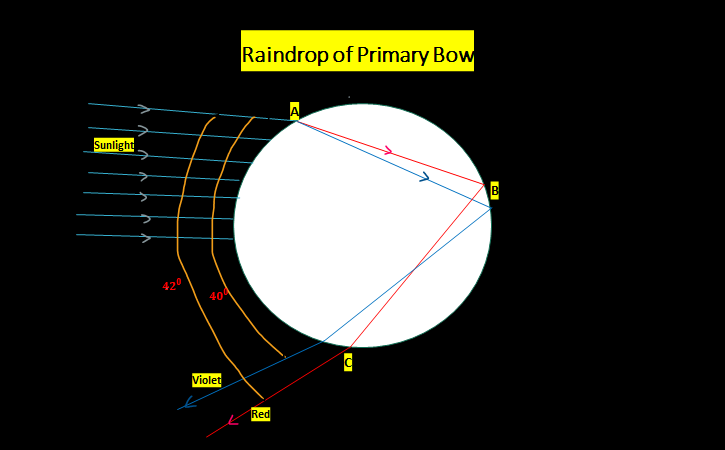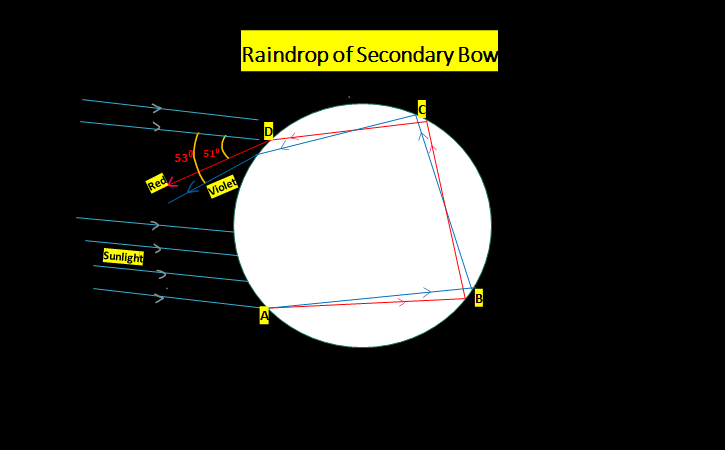Understanding the Physics Behind
Double Rainbows

Secondary Bow
Look at picture above. What an amazing double rainbow it is!! Have you ever seen such a double rainbow? When we see a rainbow, most likely, we only see the brighter bow which is the primary bow.
The fainter bow, which is outside of the dark band, is the secondary bow. It is easy to miss the secondary bow, because it is barely visible in many cases.
The dark band, between the primary bow and the secondary bow, is known as the Alexander dark band.
The Order of colors
Have you noticed anything interesting about the order of the color bands in these two bows? The color bands are precisely in the reverse order.
The primary bow has a red band outside and a violet/blue band inside. But the secondary bow has the red band inside and the violet/blue band outside.
Now, let us investigate the physics behind the secondary bow and how it forms.
Physics of Secondary Bow
Revisiting Raindrops
It is true that light rays entering any given water droplet can reflect many times inside it. But, as we discussed earlier, the primary bow is formed only by those rays that reflect once inside the droplet. Whereas the secondary bow is created by those rays that reflect twice inside the droplet before refracting as they exit the droplet.
As you can see in Fig.1, the primary bow forms from the light rays reflecting once at Point B.
But the secondary bow forms as a result of those light rays reflecting twice (Fig 2, point B and C) and finally refracting as they exist the droplet (point D of Fig.2).


Computation (for the secondary bow) shows that, at point D, violet rays come out of the droplet at 53° or greater while red rays exit the droplet at 51° or greater. Consequently, you can see the secondary bow with red band at 51°, the violet/blue band at 53°, and other colors in between.
Double bow

As you can see in Fig. 3, the primary bow forms between 40° and 42°, from the reference line, thanks to the millions of water droplets that send the dispersed sunlight to your eyes at these angles after just one internal reflection.
At the same time, the secondary bow forms between 51° and 53° thanks to the millions of other water droplets that send the dispersed sunlight, at these angles, after two internal reflections.
Now, the interesting question is why is the secondary bow fainter? That is because the amount of light that goes through two internal reflections is much less. Most of the light rays exit the droplet after just one internal reflection. So, there is not much light left to form the secondary bow.
Takeaways
Before we conclude on rainbow, let us go over the key takeaway points:
- Three conditions are to be met to see a rainbow: the sun needs to be behind you, and there should be millions of water droplets in front of you, and the sunlight should be able to reach the water droplets without any obstruction.
- The primary bow appears as a result of just one internal reflection inside the water droplets between 40° and 42°. Red band forms at 42°, violet band at 40°, and other colors in between.
- The fainter secondary bow forms as a result of two internal reflections inside the water droplets. It appears from 51° to 53°. Red band forms at 51°, violet band at 53°, and other colors in between.
- The secondary bow is fainter because the amount of sunlight that goes through two internal reflections is much less compared with just one internal reflection.
- Alexander dark band, between the primary and secondary bow, forms as there is no light coming out of any droplet between 42° and 51°.
Recommended links:
If you would like to learn more about rainbows or want to know how different exit angles in Fig.1 and Fig.2 are computed, please watch the following wonderful videos.
By Prof. Walter Lewin (MIT): https://youtu.be/iKUSWJWMSk4
The Physics of Rainbow: https://youtu.be/M90XEREe66s
